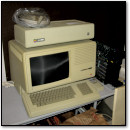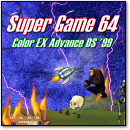Archive for the 'Design' Category
Benj’s Steve Wozniak Interview on Gamasutra
Friday, May 4th, 2007 Back in February, I conducted a nice interview with Steve Wozniak (“Woz”), co-founder of Apple Computer, that mostly focused on video and computer games. The piece is now on Gamasutra for all to read. Woz talks about how the Apple II design was inspired by video games, his love of Tetris, Steve Jobs as a gamer, and more.
Back in February, I conducted a nice interview with Steve Wozniak (“Woz”), co-founder of Apple Computer, that mostly focused on video and computer games. The piece is now on Gamasutra for all to read. Woz talks about how the Apple II design was inspired by video games, his love of Tetris, Steve Jobs as a gamer, and more.
You might remember that I previously did a Ralph Baer interview for Gamasutra. This Woz interview is only the latest in a series. There are more to come, so stay tuned.
Retro Scan of the Week Special Edition: “At Last! Reality For the Masses!”
Monday, April 30th, 2007 There was a time in the early 1990s when “Virtual Reality” via bulky goggles strapped to your head seemed like the promise of the future. Video game console manufacturers like Atari, Sega, and Nintendo all dipped their toes into the virtual reality waters, but none devised a practical and cost-effective solution. Those attempting to create affordable consumer VR headsets encountered common problems: a true stereo display using two high resolution color LCD screens and motion tracking was too expensive, and even high quality goggles caused serious motion sickness and disorientation with many users.
There was a time in the early 1990s when “Virtual Reality” via bulky goggles strapped to your head seemed like the promise of the future. Video game console manufacturers like Atari, Sega, and Nintendo all dipped their toes into the virtual reality waters, but none devised a practical and cost-effective solution. Those attempting to create affordable consumer VR headsets encountered common problems: a true stereo display using two high resolution color LCD screens and motion tracking was too expensive, and even high quality goggles caused serious motion sickness and disorientation with many users.
Apparently VictorMaxx knew something that companies with multi-million dollar R&D budgets didn’t. They released the StuntMaster VR, a “3-D interactive virtual reality” headset with seemingly impressive motion tracking capability (“point-of-view instantly scrolls or rotates with the turn of your head!”). But alas, I own one, and I know that VictorMaxx only surpassed the competition in hyperbole and false advertising. The StuntMaster VR is a terrible piece of junk.
 Imagine that: reality for the masses.
Imagine that: reality for the masses.
Dare you step forward, cheeze ball? Despite what the box says, the StuntMaster VR is not a 3D display. It contains one extremely grainy low resolution LCD screen in the center of the goggles. If you put it on, it hurts your face. The display singes your retinas with an intensely fuzzy,  hard-to-focus-on image. The head tracking mechanism is nothing more than a stick you clip to your shoulder (see picture above) which slides through a loop on the side of the headset. When you turn your head, the StuntMaster detects the stick sliding in the loop and translates this into a left or right button press on a control pad, assuming you’ve actually hooked it up to the controller port of your SNES or Genesis. Remember the “point-of-view instantly scrolls or rotates with the turn of your head” quote? I’d love to see that happen in Super Mario World. Obviously, it couldn’t actually work unless the game were programmed for that functionality in advance. Unless, of course, you’re playing Doom and you want to turn left or right by moving your head.
hard-to-focus-on image. The head tracking mechanism is nothing more than a stick you clip to your shoulder (see picture above) which slides through a loop on the side of the headset. When you turn your head, the StuntMaster detects the stick sliding in the loop and translates this into a left or right button press on a control pad, assuming you’ve actually hooked it up to the controller port of your SNES or Genesis. Remember the “point-of-view instantly scrolls or rotates with the turn of your head” quote? I’d love to see that happen in Super Mario World. Obviously, it couldn’t actually work unless the game were programmed for that functionality in advance. Unless, of course, you’re playing Doom and you want to turn left or right by moving your head.
 A disturbing, tragic world, yours? Then please, do not buy the StuntMaster VR headset. Mine was so useless that I took it apart about four years ago and wired up some connectors to use it as a tiny LCD monitor. Even then, the LCD screen’s extremely low resolution makes it nearly useless. So now it spends most of its days sitting in its box, partially disassembled, reflecting on the good old days when plants were still green and the Lawnmower Man played out like a guaranteed guide to the future. I still want one of those springy mid-air virtual reality harnesses, by the way.
A disturbing, tragic world, yours? Then please, do not buy the StuntMaster VR headset. Mine was so useless that I took it apart about four years ago and wired up some connectors to use it as a tiny LCD monitor. Even then, the LCD screen’s extremely low resolution makes it nearly useless. So now it spends most of its days sitting in its box, partially disassembled, reflecting on the good old days when plants were still green and the Lawnmower Man played out like a guaranteed guide to the future. I still want one of those springy mid-air virtual reality harnesses, by the way.
The StuntMaster headset makes me wonder how long VictorMaxx stayed in business. Who knows, we might hear from a former employee in time. Did anybody else have one of these, or any other VictorMaxx products? Leave a comment and we’ll talk.
If you use these images on your site, please support “Retro Scan of the Week” by giving us obvious credit for the original scan and entry. Thanks.
Retro Scan of the Week: Wico Computer Command Joystick
Monday, April 16th, 2007
Did/does anybody have one of these and wish to share their thoughts on it?
[ From Personal Computing magazine, December, 1983. ]
If you use this image on your site, please support “Retro Scan of the Week” by giving us obvious credit for the original scan and entry. Thanks.
Retro Scan of the Week: The Art of the Vectrex Overlay
Monday, January 22nd, 2007 For those of you who might not know, the GCE Vectrex (1983) was a unique game system that had a built in black and white vector graphics display. Vector graphics are composed of lines drawn point-to-point on a specially-driven CRT rather than through a bit-mapped pixel graphics method on a raster scan display (like an ordinary TV set). That may be a bit too technical for you, but the least you need to know is that vector graphics are different than usual and, in the case of the Vectrex, consisted of white lines on black backgrounds only.
For those of you who might not know, the GCE Vectrex (1983) was a unique game system that had a built in black and white vector graphics display. Vector graphics are composed of lines drawn point-to-point on a specially-driven CRT rather than through a bit-mapped pixel graphics method on a raster scan display (like an ordinary TV set). That may be a bit too technical for you, but the least you need to know is that vector graphics are different than usual and, in the case of the Vectrex, consisted of white lines on black backgrounds only.
In order to spice up the system’s monochrome gameplay, each Vectrex game came with its own custom translucent colored overlay that snapped in place over the Vectrex’s built-in monitor. The white vector lines on the monitor underneath shone through and gave the illusion of a color display for certain parts of the screen. The one you see above is for Flipper Pinball. Notice the different regions of the play field which have different colors to add more life and variety to the game.
It should be noted that colored overlays were not a new idea to the Vectrex. Their use in video games spans back to the medium’s very genesis, from the days of Ralph Baer experimenting in his lab at Sanders, and later on the first video game system ever, the Magnavox Odyssey. Also, most early arcade games used black and white displays with colored overlays to keep production costs down, as the components needed to generate and the monitors needed to display colored graphics were expensive at the time.
Personally, I’ve never been a fan of overlays — I find them a chintzy substitute for a true color display, and instead prefer to play my Vectrex games without them. Monochrome ain’t so bad.
If you use this image on your site, please support “Retro Scan of the Week” by giving us obvious credit for the original scan and entry. Thanks.
Why Super Nintendos Lose Their Color: Plastic Discoloration in Classic Machines
Friday, January 12th, 2007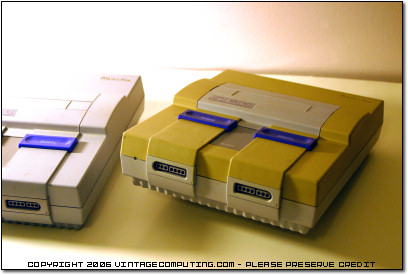
Sure, consoles age and get dirty. Heck, I remember a suspicious incident involving my Super Nintendo (SNES) console and a can of Coca-Cola in the early ’90s that left my SNES looking more like a moldy loaf of bread than a video game system. But around five years ago, I noticed that my SNES console was aging particularly badly. I cleaned off all the remnants of fossilized Coke residue from the chassis with a wet washcloth, but the “moldy bread” look still remained. The top half of the console’s plastic body retained a uniformly nasty yellow-brown hue, while the bottom half flaunted its showroom shine — that native SNES gray that we all know and love. I soon realized that a much deeper mechanism was responsible for the aesthetic disfigurement of my beloved SNES than mere dirt and sugar.
To further complicate matters, I have another SNES unit that was obviously produced more recently than my original one, and that console shows no sign of aging whatsoever. Comparing the units and the way different parts of them had discolored led me to believe that there is something different about the two batches of plastics — the one for the top half of the SNES chassis and the one for the bottom, or the plastic for the old unit and plastic for the new — that made them age differently over time.
Immediately below are two photos I took of my actual SNES units. Notice the difference between the colors of the top and bottom halves of the plastic chassis on the older unit, and also how the newer unit shows no sign of discoloration at all.
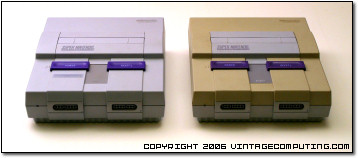 My first SNES console (right) exhibits discoloration on the top half only.
My first SNES console (right) exhibits discoloration on the top half only.
The newer unit on the left, however, looks as good as new.
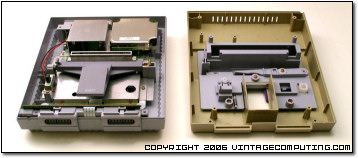 The top half and bottom half of my first SNES console, disassembled.
The top half and bottom half of my first SNES console, disassembled.
Notice that the underside is yellowed with the same uniformity as the top.
Retro Scan of the Week: Some Wood For Your ‘Stick
Monday, November 20th, 2006
A Bit of (Fictional) Trivia: The president of Skywriter, Larry Egler, was once famously quoted as saying, “There will be a Stick Station on every table in America by 1990.” Few people know that it was a misquote that has been erroneously reprinted in many books on video game history. In truth, Mr. Egler said, “There will be a table on every Stick Station in America by 1990,” a prediction that actually came true: all remaining Stick Stations in the continental United States are now being used to shore up wobbly table legs.
[ From Computer Games, June 1984. Special thanks to McPhail Hunt for donating the issue. ]
If you use this image on your site, please support “Retro Scan of the Week” by giving us obvious credit for the original scan and entry. Thanks.
Retro Scan of the Week: “So You Want to Be a Video Games Inventor”
Sunday, November 5th, 2006
(Ok…the article says 35, but still.)
This scan came from the premiere (Winter 1982) issue of “Odyssey² Adventure Club Magazine,” Magnavox’s official monthly magazine / propaganda pamphlet for Odyssey² fans — sorta like Nintendo Power these days. Actually, “Odyssey² Adventure” is more a newsletter than a magazine, since all the issues I have are only about fifteen pages long. Nonetheless, this article is an amusing look into the world of Odyssey² game developers, straight from the horse’s mouth.
A quick compare-and-contrast of these guys with Atari’s “pot-smoking hippie” game programmer image of the late 1970s and even today’s “early twenties slacker” programmers makes the Odyssey folks look like a bunch of straight-laced leprechaun engineers. Ralph Baer, what hath thou wrought!
If you use this image on your site, please support “Retro Scan of the Week” by giving us obvious credit for the original scan and entry. Thanks.
Eric’s Look at Trippy Computer Games
Tuesday, September 19th, 2006 Back in the good old days of computer gaming (we’re talking late-80’s to mid-90’s here, folks), one thing that could be said about the games market is that it was a crap shoot. Before the advent of the Internet, the few dead-tree review magazines couldn’t keep up with the number of newly-released titles, and computer game companies didn’t seem to take advertising very seriously. This meant that the chances of knowing the details of a game before purchasing it were pretty slim. Usually, all a gamer had to go on was the box copy, and whatever word-of-mouth could be picked up while hanging out at the local Babbage’s.
Back in the good old days of computer gaming (we’re talking late-80’s to mid-90’s here, folks), one thing that could be said about the games market is that it was a crap shoot. Before the advent of the Internet, the few dead-tree review magazines couldn’t keep up with the number of newly-released titles, and computer game companies didn’t seem to take advertising very seriously. This meant that the chances of knowing the details of a game before purchasing it were pretty slim. Usually, all a gamer had to go on was the box copy, and whatever word-of-mouth could be picked up while hanging out at the local Babbage’s.
Buying a game could be a gamble, pure and simple. Sure, Origin was a safe bet for action or role-playing, and Sierra was the uncontested king of the adventure genre, but so many smaller companies were trying to make it big that it was impossible to know exactly what would be on the shelf on any given day. Sometimes, a search though the $5 rack would reveal an unlikely-sounding game written by two guys in a smelly basement, only to be unmasked later as a true gem of programming skill. More often, a slick-looking box with beautiful images and promising descriptions would turn out, when unboxed at home, to fall somewhere between maddeningly dull and outright unplayable (I’m looking at you, Rocket Jockey). But rarely, very rarely, a game would crop up that would cause an immediate and almost-universal reaction among gamers: “What were those guys smoking, and where can I get some?”
Eric’s Look at Recycled PC Game Ideas
Wednesday, August 23rd, 2006 [ In this article, I’m testing a new image preview method. You can see a larger version of most images by hovering your mouse cursor over an image. Please let me know if you encounter any problems with this. — The Editor ]
[ In this article, I’m testing a new image preview method. You can see a larger version of most images by hovering your mouse cursor over an image. Please let me know if you encounter any problems with this. — The Editor ]
Breakthrough technology. Innovative gameplay. Revolutionary features. It seems that every new game claims to incorporate some aspect that players have never seen before. From a marketing standpoint, that’s understandable. We all want value for our money, and what better hook is there than offering a fresh experience? What better enticement is there than a style of game we’ve never seen before?
Wolfenstein 3D and Doom reshaped the gaming market almost overnight by giving players a chance to step into the skin of their character. When Diablo first hit the shelves, one of its biggest selling points was the nearly-unlimited replayability afforded by its randomly-generated maps and quests. And Neverwinter Nights boasts one of the strongest online communities around, due in part to the extremely powerful editing tools that allow users to create adventures every bit as polished as what the game shipped with.
These titles are all examples of truly unique, one-of-a-kind ideas dominating, and changing, the gaming world. Or at least, they would be, if the ideas behind them really were unique. But how many gamers remember titles like Ultima Underworld, Castle of the Winds, Mordor, and Shattered Light?
[ Continue reading Eric’s Look at Recycled PC Game Ideas » ]



